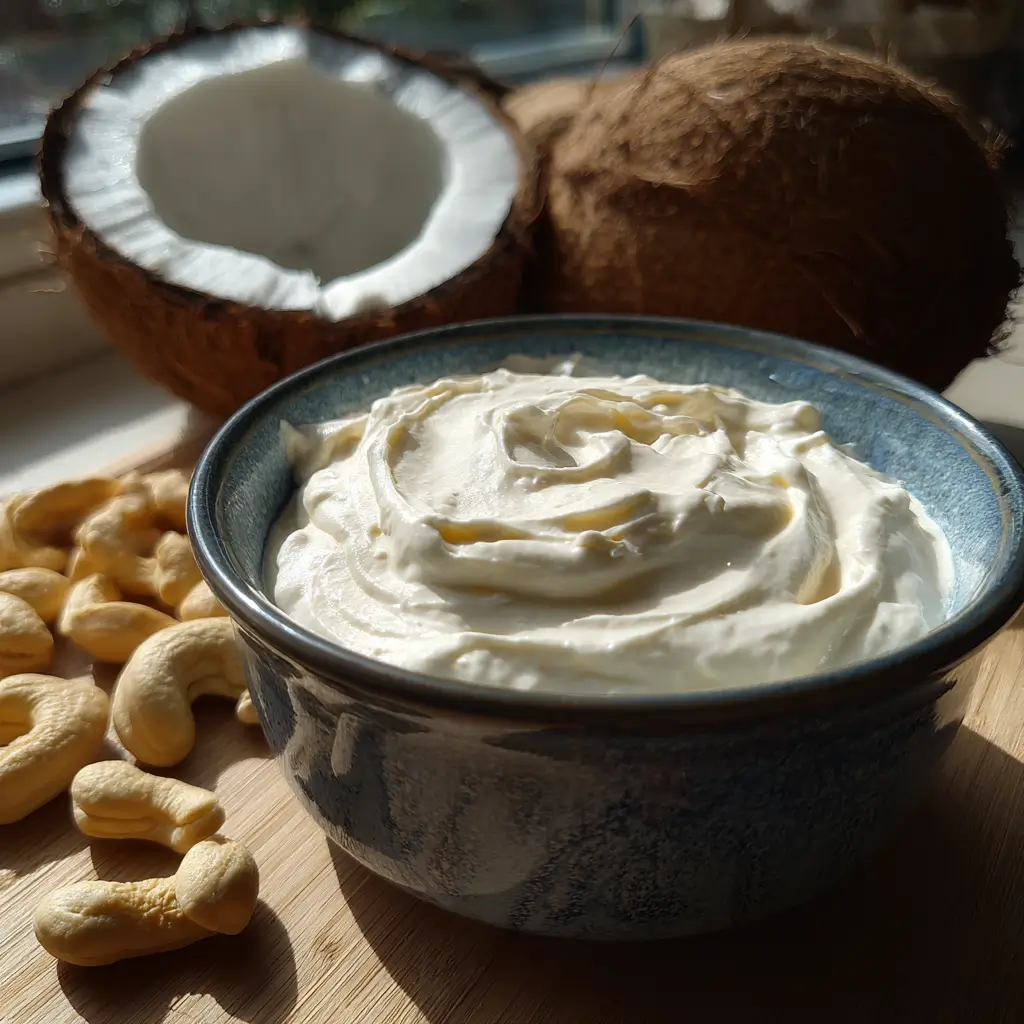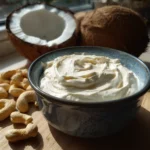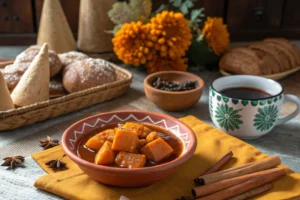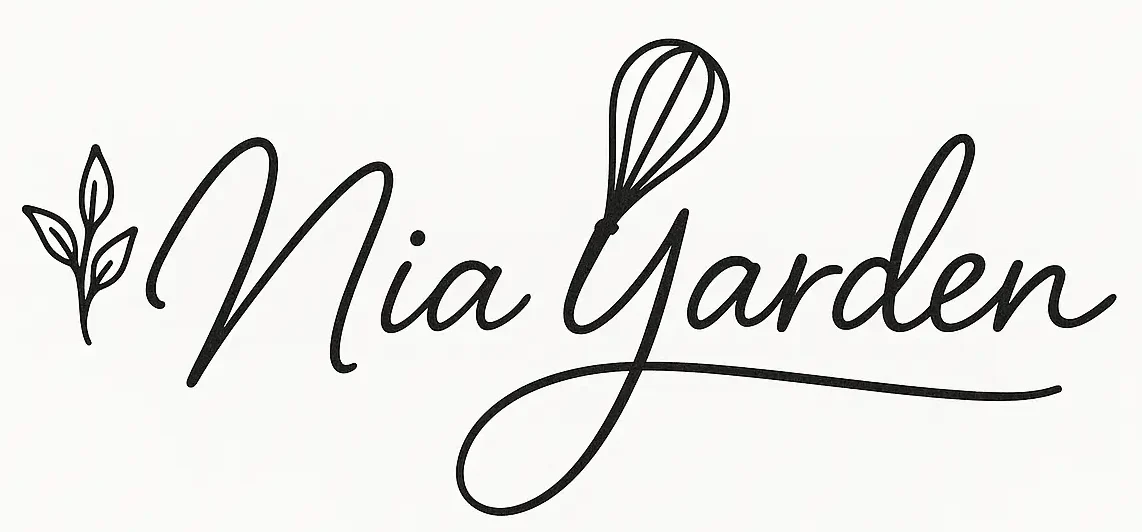If you’ve ever struggled to find that perfect creamy texture without the dairy, you’re not alone. Whether you’re lactose intolerant, vegan, or just trying to eat cleaner, dairy free cream offers rich, delicious alternatives for your cooking and baking needs. In this guide, we’ll explore the most popular types of non-dairy creams, how to make them at home, the best store brands, and how to use them in recipes without sacrificing taste or texture. Looking for inspiration? Try our dairy-free coffee creamer guide to kick-start your mornings with flavor!
Table of Contents
Let’s dive into everything you need to know about dairy free cream so you can feel confident in the kitchen and your food choices.
PrintHomemade Cashew Dairy Free Cream
A rich and creamy dairy-free cashew cream made with just three ingredients. Perfect for vegan sauces, dips, and baking.
- Prep Time: 5 minutes
- Cook Time: 0 minutes
- Total Time: 5 minutes
- Yield: 1 cup 1x
- Category: Sauces & Dips
- Method: Blending
- Cuisine: Plant-Based
- Diet: Vegan
Ingredients
1 cup raw cashews (soaked for at least 4 hours or overnight)
¾ cup water (plus more for soaking)
1/4 tsp sea salt (optional)
Instructions
Drain soaked cashews and rinse under cold water.
Add cashews and ¾ cup fresh water to a high-speed blender.
Blend until completely smooth and creamy (1–2 minutes).
Add salt to taste and blend for a few more seconds.
Store in an airtight jar in the refrigerator for up to 5 days.
Notes
For a thinner cream, add an additional 2–3 tablespoons of water while blending.
For extra flavor, add 1 tbsp lemon juice or garlic if using in savory dishes.
Make it sweet: Add a date or vanilla for dessert-style cream.
Nutrition
- Serving Size: 2 tbsp
- Calories: 85
- Sugar: 1g
- Sodium: 35mg
- Fat: 7g
- Saturated Fat: 1g
- Unsaturated Fat: 6g
- Trans Fat: 0g
- Carbohydrates: 5g
- Fiber: 1g
- Protein: 3g
- Cholesterol: 0mg
PART 1: Understanding Dairy Free Cream
What is dairy free cream?
Dairy free cream is a plant-based or non-animal derived alternative to traditional cream made from cow’s milk. Unlike regular cream that contains lactose and milk proteins like casein, dairy free options use ingredients like coconut milk, cashews, almonds, oats, and soy to mimic the same rich texture and mouthfeel.
You’ll find these creams labeled as “non-dairy,” “plant-based,” or “vegan,” and they’re designed for cooking, baking, or even pouring into your morning coffee. These creams contain no animal-based ingredients, making them suitable for vegans, people with dairy allergies, and those avoiding lactose.
Some of the most common bases used in dairy free creams include:
- Coconut: Thick, rich, and ideal for desserts or sauces
- Cashews: Ultra-creamy and versatile in both sweet and savory dishes
- Oats: Mild flavor and great for light creams
- Almonds: Nutty and commonly used in beverages or whipped toppings
- Soy: Protein-rich and more stable in cooking
Why choose dairy free over traditional cream?
There are several compelling reasons to make the switch to dairy free cream:
- Lactose intolerance: Millions of people in the U.S. are lactose intolerant and experience bloating, gas, or discomfort after consuming dairy.
- Vegan and plant-based lifestyle: If you’re cutting out animal products for ethical or health reasons, dairy free cream is a must-have staple.
- Allergies or sensitivities: Even if you’re not lactose intolerant, you might have issues with casein or whey, which are proteins found in dairy.
- Health benefits: Some plant-based creams are lower in saturated fat and cholesterol than traditional cream.
- Environmental impact: Producing plant-based foods typically has a lower carbon footprint than dairy farming.
In terms of versatility, most non-dairy creams are just as capable of delivering richness and creaminess in cooking. Whether it’s for soups, sauces, whipped toppings, or dessert fillings, there’s a dairy free option that fits the bill.
Discover great ideas like our indulgent dairy-free ice cream cake recipe to explore how delicious dairy-free life can be.
PART 2: Popular Types of Dairy Free Cream
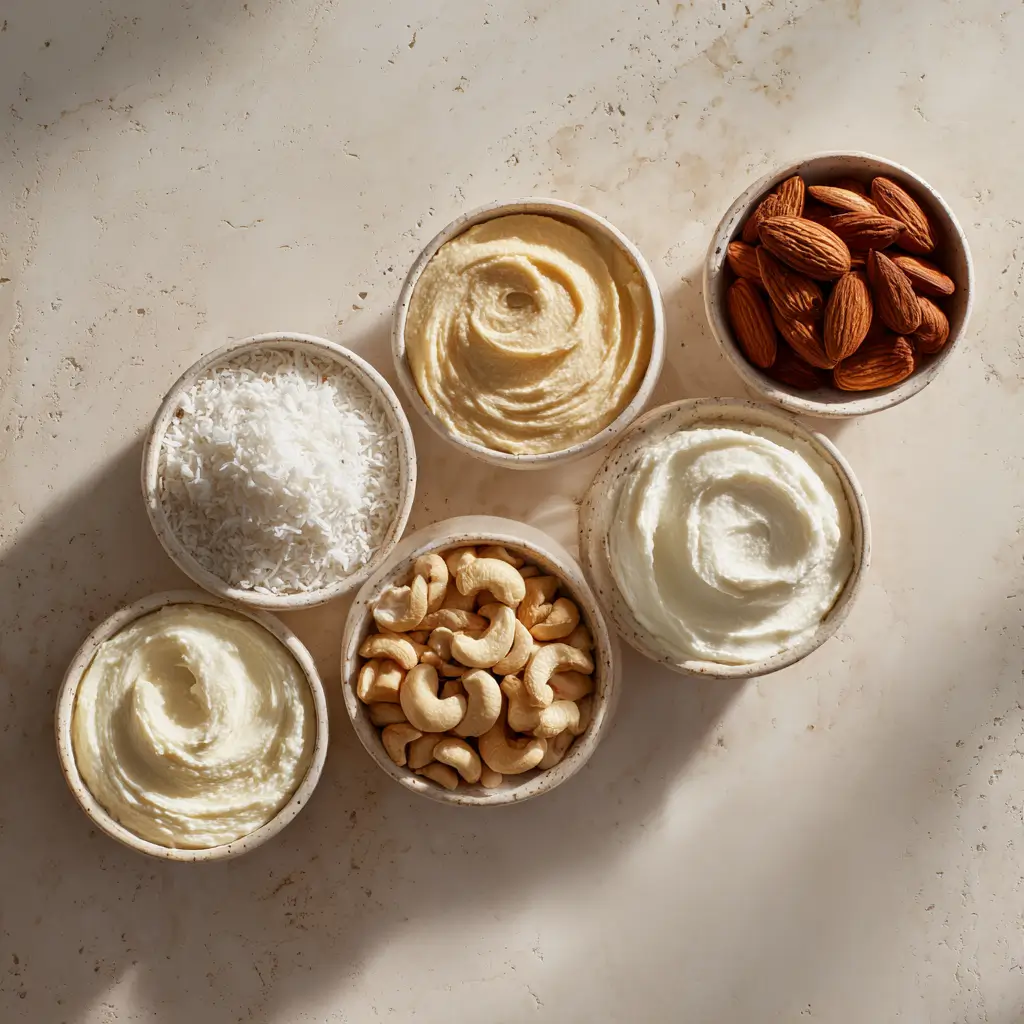
Coconut cream, almond cream, and oat cream
Coconut cream is one of the richest and most popular dairy free cream options. It’s made by skimming the thick layer from canned coconut milk. Its naturally high fat content makes it perfect for curries, desserts, and even whipped toppings. It’s slightly sweet and has a distinct coconut flavor that works well in tropical or Asian dishes.
Almond cream offers a lighter alternative. It’s made by blending soaked almonds with water and straining the mix until smooth. Almond cream has a mild nutty flavor and works beautifully in both coffee and savory recipes like pasta sauces.
Oat cream, relatively new to the scene, is quickly gaining popularity. Made by blending oats with water and straining, oat cream is neutral in flavor, slightly sweet, and great in both sweet and savory applications. Plus, it’s allergy-friendly for those avoiding nuts and soy.
| Type | Best For | Texture | Flavor Profile |
|---|---|---|---|
| Coconut Cream | Desserts, curries, whipped cream | Thick & Rich | Sweet, coconutty |
| Almond Cream | Coffee, pasta, soups | Light | Mild, nutty |
| Oat Cream | Sauces, baked goods | Smooth | Neutral, slightly sweet |
Check out our smooth and rich dairy-free ice cream guide to see how these creams can take your desserts to the next level.
Cashew cream and soy cream explained
Cashew cream is often the favorite of vegan chefs. Soaked cashews are blended with water (and sometimes lemon juice or nutritional yeast) into a silky, thick cream. It’s incredibly versatile: use it in vegan alfredo, creamy soups, or even cheesecakes. Cashews have a naturally neutral and buttery flavor, making this cream an all-purpose superstar.
Soy cream is another solid contender, especially in commercial and store-bought options. It has a slightly bean-like taste but is rich in protein and very stable under heat, which makes it ideal for cooking. It’s often used as a direct replacement for dairy cream in sauces, gravies, and quiches.
Together, these dairy free creams offer endless culinary flexibility, proving that ditching dairy doesn’t mean ditching flavor or texture.
Don’t miss our dairy-free mac and cheese recipe that features ultra-creamy cashew-based sauce you’ll love.
PART 3: How to Make Dairy Free Cream at Home
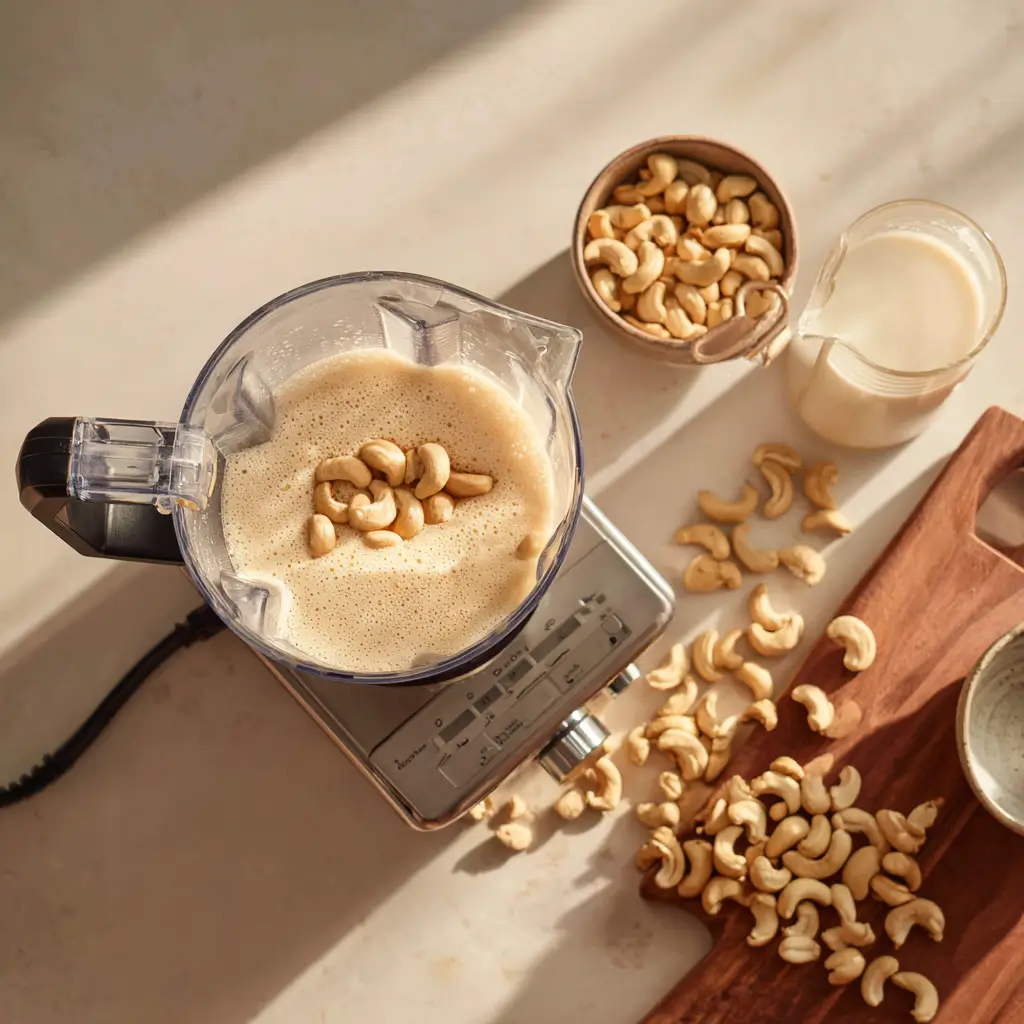
Simple homemade dairy free cream recipes
Making dairy free cream at home is not only simple, but it also gives you complete control over the ingredients. Here are three foolproof recipes to try:
1. Coconut Cream
- Ingredients: 1 can full-fat coconut milk
- Instructions: Chill the can overnight. Scoop the thickened top layer into a bowl, leaving the watery part behind. Whisk or blend for extra fluffiness.
- Use For: Whipped cream, desserts, curries
2. Cashew Cream
- Ingredients: 1 cup raw cashews (soaked 4 hours), ¾ cup water, pinch of salt
- Instructions: Drain cashews, blend with water and salt until smooth and creamy.
- Use For: Pasta sauces, soups, vegan cheesecake
3. Oat Cream
- Ingredients: 1 cup rolled oats, 2 cups water
- Instructions: Blend oats and water, strain through cheesecloth or nut milk bag. Optionally add a splash of oil for richness.
- Use For: Coffee, baking, sauces
All of these homemade options are budget-friendly, customizable, and free from preservatives or additives found in many store-bought brands.
Tips for creamy consistency without dairy
Achieving a creamy texture without dairy isn’t about replacing milk 1:1 — it’s about balancing fat and texture. Here’s how to make sure your homemade creams stay velvety and rich:
- Use a high-speed blender – Essential for breaking down nuts and oats into smooth cream without grit.
- Soak nuts properly – This softens the texture and improves blendability.
- Strain well – Especially with oat-based creams, straining helps eliminate any graininess.
- Add healthy fats – A teaspoon of avocado oil or melted coconut oil can boost creaminess and mouthfeel.
- Don’t overblend oats – With oat cream, blending too long can make it slimy due to the starches.
Need a beginner-friendly base recipe? Learn more about how to transform pantry staples with our guide to is vegan dairy free?.
PART 4: Best Dairy Free Cream Brands to Try
Store-bought options and reviews
When convenience matters, store-bought dairy free cream is a lifesaver. Today’s market is full of fantastic options that rival traditional cream in texture, taste, and performance. Here are some of the top-rated choices in the U.S., along with mini reviews:
1. So Delicious Culinary Coconut Milk
- Base: Coconut
- Best For: Cooking, desserts
- Review: Thick and rich with a clean coconut flavor. Excellent for curries and baking.
2. Califia Farms Heavy Whip Cream Alternative
- Base: Coconut and sunflower oil
- Best For: Whipping, topping desserts
- Review: Whips just like dairy cream. Slightly sweet but fluffy and smooth.
3. Silk Dairy-Free Heavy Whipping Cream
- Base: Coconut and sunflower oil
- Best For: Savory dishes, sauces, coffee
- Review: Neutral flavor, reliable thickness, and widely available in most U.S. supermarkets.
4. Elmhurst Cashew Cream
- Base: Cashews
- Best For: Vegan sauces, dips, creamy pastas
- Review: Luxurious, buttery texture and easy to use in both cold and hot applications.
5. Oatly Whippable Creamy Oat
- Base: Oats
- Best For: Baking, fruit toppings
- Review: Light and airy, slightly sweet. Great allergy-friendly choice.
| Brand | Base Ingredient | Best Use | Key Highlight |
|---|---|---|---|
| So Delicious | Coconut | Cooking & desserts | Bold coconut flavor |
| Califia Farms | Coconut & oil | Whipping & toppings | Fluffy, dairy-like whip |
| Silk | Coconut & oil | Coffee & sauces | Widely available, neutral |
| Elmhurst | Cashew | Sauces & dips | Rich and buttery texture |
| Oatly | Oats | Baking, topping fruit | Allergy-friendly and light |
Looking for a topping for that sundae? Don’t miss our indulgent dairy-free ice cream recipe — it pairs perfectly with any of these creams.
What to look for on labels
Shopping smart means reading labels carefully. Not all “non-dairy” or “plant-based” creams are created equal. Here’s what to check before you buy:
- Watch for hidden dairy terms – Avoid products with casein, whey, or lactose.
- Check for stabilizers or gums – Ingredients like guar gum and carrageenan help texture but can irritate sensitive stomachs.
- Look for unsweetened versions – Especially if you’re using the cream for savory cooking.
- Allergen-friendly certification – If you’re avoiding nuts or gluten, choose brands that are certified allergen-free.
- Minimal ingredient lists – Fewer additives usually mean a cleaner, more wholesome product.
Understanding what’s in your cream helps you avoid surprises and ensures it fits your dietary goals.
Want to know more about hidden dairy? Learn all about is ghee dairy free and why labels can be misleading.
PART 5: Dairy Free Cream in Cooking and Baking
How to use dairy free cream in savory dishes
Swapping in dairy free cream for traditional cream doesn’t mean sacrificing flavor or texture—especially when you use the right type of cream for the job. In savory cooking, richness and mouthfeel are key. Here’s how to do it right:
1. Creamy Soups & Bisques
Use coconut cream or cashew cream to add a velvety texture to tomato bisque, mushroom soup, or butternut squash puree. Their high fat content mimics the richness of dairy.
2. Pasta Sauces
Cashew cream makes an excellent base for dairy-free Alfredo or vodka sauces. You can also blend in garlic, lemon, and nutritional yeast for a cheesy twist.
3. Casseroles & Curries
Oat cream and soy cream hold up well under heat and won’t curdle, making them perfect for baked dishes and curries.
4. Mashed Potatoes
Add almond or oat cream to your mash for a light, buttery texture without the dairy.
| Dish Type | Best Dairy Free Cream | Tip |
|---|---|---|
| Soups & Bisques | Coconut, Cashew | Blend with roasted veggies |
| Pasta Sauces | Cashew | Add garlic and lemon for zing |
| Curries | Coconut, Soy | Simmer gently for depth of flavor |
| Casseroles | Oat, Almond | Use unsweetened versions |
| Mashed Potatoes | Almond, Oat | Whip for fluffy, smooth texture |
Looking for comfort food ideas? Discover our creamy dairy-free mac and cheese made with cashew cream — it’s a family favorite!
Tips for replacing dairy cream in baked recipes
Baking with dairy free cream is all about understanding fat and liquid ratios. Here are pro tips to make your desserts stand out:
- Whipping Cream Substitutes
For whipped toppings, use chilled coconut cream or store-bought whippable oat or almond cream. Be sure it’s labeled “whippable.” - Moisture in Cakes
Oat and almond cream help keep cakes moist. Swap 1:1 for heavy cream or half-and-half. - Ganache and Fillings
Cashew cream creates rich, luxurious ganache. Add melted dairy-free chocolate for a simple truffle base. - Avoid Sweetened Creams in Savory Baking
Many non-dairy creams are pre-sweetened. Check labels to avoid unexpected sweetness in savory pies or quiches. - Adjust Bake Times
Plant-based creams may brown differently. Keep an eye on your oven to avoid overbaking.
Don’t miss our guide on dairy-free ice cream cake — it’s a fantastic way to use non-dairy whipped cream and frosting in a show-stopping dessert.
PART 6: Health Benefits and Nutritional Comparison
Comparing dairy cream vs. dairy free cream
When comparing dairy free cream to traditional dairy cream, the differences go beyond just ingredients. The nutritional profile can shift significantly depending on the base—whether it’s coconut, oat, soy, or nut-based. Here’s how they stack up:
| Nutrient | Dairy Cream (Heavy) | Coconut Cream | Cashew Cream | Oat Cream | Soy Cream |
|---|---|---|---|---|---|
| Calories (per 2 tbsp) | 100–120 | ~90 | ~80 | ~50 | ~60 |
| Fat | 10–12g | 9g | 7g | 3g | 5g |
| Saturated Fat | 7g | 8g | 1g | 0.5g | 0.5g |
| Cholesterol | 35mg | 0mg | 0mg | 0mg | 0mg |
| Protein | 0g | 1g | 2g | 1g | 2g |
| Fiber | 0g | 0g | 1g | 1g | 1g |
Key takeaways:
- No cholesterol: All dairy free options are cholesterol-free.
- Less saturated fat: Except for coconut cream, most plant-based creams are significantly lower in saturated fat.
- Better for heart health: Cashew, oat, and soy creams offer healthier fats and may support better cardiovascular health.
- Fewer calories: Most dairy free creams are lower in calories than traditional cream.
So if you’re managing heart health, cholesterol, or calorie intake, dairy free cream is often a better option. It’s also naturally lactose-free, making it safer for those with dairy sensitivities.
Digestive, allergy, and vegan lifestyle benefits
Digestive health: Many people suffer from bloating or cramping after consuming dairy. Since dairy free cream doesn’t contain lactose, it’s easier to digest and gentler on your gut.
Food allergies: Dairy is one of the top eight allergens. By using plant-based cream, you eliminate the risk of triggering dairy allergies. Plus, there are nut-free options like oat and soy cream for those with additional sensitivities.
Vegan and ethical lifestyle: For vegans, dairy free cream is a no-brainer. It aligns with a plant-based diet and avoids the ethical concerns associated with animal farming.
Environmental impact: Producing non-dairy cream has a much lower carbon footprint than dairy farming. Almond, oat, and soy production use fewer resources and generate less greenhouse gas emissions.
Switching to dairy free cream isn’t just about avoiding dairy—it’s a holistic upgrade for health, ethics, and the environment.
PART 7: FAQs About Dairy Free Cream
In this section, we’re addressing the most common questions people have about dairy free cream based on real search queries. Let’s clear up the confusion with clear, concise answers.
What creams are dairy-free?
Dairy-free creams are made from plant-based ingredients and contain no milk or lactose. Common types include:
Coconut cream – thick, rich, and ideal for desserts or curries
Cashew cream – neutral and creamy, perfect for sauces and soups
Almond cream – light with a nutty flavor, great in coffee
Oat cream – smooth and allergy-friendly, useful in baking and cooking
Soy cream – protein-rich and stable for heating
These creams are often labeled as “non-dairy,” “plant-based,” or “vegan” and can be used in a wide variety of dishes.
What is a dairy-free substitute for cream?
The best dairy-free substitutes for cream depend on your recipe:
For whipped cream: Use chilled coconut cream or a product like Califia Farms Whip
For sauces: Cashew cream or oat cream offer a smooth, rich base
For coffee: Almond, soy, or oat creamers work well
For baking: Oat or soy cream keeps baked goods moist
Many of these can be made at home or found in stores under vegan or plant-based product labels.
Can you get non-dairy cream?
Yes, non-dairy cream is widely available in grocery stores, especially in the natural foods or plant-based section. Brands like:
Silk
Califia Farms
So Delicious
Elmhurst
Oatly
offer a range of non-dairy creams for cooking, coffee, or baking. These products mimic the texture and flavor of dairy cream without using milk.
Looking for a reliable everyday creamer? Learn more about options in our dairy-free coffee creamer guide.
Is vegan dairy free?
Yes, all vegan products are inherently dairy free. A vegan diet excludes all animal products, including milk, butter, and cream. However, not all dairy-free products are vegan—some may still contain animal-derived ingredients like gelatin or honey. Always check the label if you follow a strict vegan lifestyle.
Don’t miss our complete breakdown in is vegan dairy free.
Is ghee dairy free?
No, ghee is not technically dairy-free. Although it’s clarified and contains little to no lactose or casein, it is still made from butter, which comes from milk. That said, some people with mild lactose intolerance can tolerate ghee, but it’s not suitable for vegans or those with dairy allergies.
Explore more in our detailed guide: is ghee dairy free?.
PART 8: Common Mistakes to Avoid
Even with the best intentions, switching to dairy free cream can come with a learning curve. Here are the most common missteps to watch out for — and how to avoid them.
Misreading labels with hidden dairy
One of the biggest pitfalls is assuming that “non-dairy” always means dairy-free. Unfortunately, that’s not always the case.
Watch out for hidden dairy ingredients:
- Casein (a milk protein)
- Whey
- Lactose
- Butterfat
- Milk solids
Many non-dairy products — especially coffee creamers — can still contain these components. Always read the ingredient list carefully, and look for products that are clearly labeled “dairy-free” or “vegan.”
Pro Tip: Products certified “vegan” are guaranteed to be dairy-free. That label is your best friend.
Not testing substitutes in recipes first
Another common mistake is swapping in a dairy-free cream without testing it in your specific recipe. Different creams behave differently when heated, blended, or baked.
Examples:
- Coconut cream may curdle in acidic dishes unless added slowly
- Oat cream may thicken too much if overcooked
- Almond cream can separate if boiled too quickly
- Homemade cashew cream may need straining for ultra-smooth results
What to do instead:
- Test the cream in a small portion of your dish first
- Add plant-based cream near the end of cooking
- If baking, do a trial run to check texture and moisture
Getting to know how each cream works helps ensure you get the texture and taste you expect every time.
Choosing the wrong cream for the dish
Not every plant-based cream suits every dish. Here’s a quick cheat sheet to avoid mismatches:
| Dish Type | Avoid This Mistake | Use This Instead |
|---|---|---|
| Whipped toppings | Using almond or soy (won’t whip) | Use coconut cream or store-bought whips |
| Sauces and gravies | Using sweetened coffee creamers | Use unsweetened oat or soy cream |
| Coffee | Using thick coconut cream (too oily) | Use almond, oat, or barista blends |
| Baked goods | Using low-fat options (too thin) | Use cashew or oat for moisture |
PART 9: Recipes Using Dairy Free Cream

Whether you’re looking for savory comfort food or luscious desserts, dairy free cream makes it all possible. These easy recipes will show you just how versatile non-dairy options can be.
Creamy pasta, soups, desserts
1. Vegan Alfredo Pasta with Cashew Cream
- Ingredients: Soaked cashews, garlic, lemon juice, nutritional yeast, plant milk
- How to make: Blend into a silky sauce and pour over fettuccine. Sauté mushrooms or broccoli for extra flavor.
- Why it works: Cashew cream delivers thickness and a mild flavor that absorbs seasonings beautifully.
2. Butternut Squash Soup with Coconut Cream
- Ingredients: Roasted squash, onions, garlic, veggie broth, coconut cream
- How to make: Blend roasted squash with broth and sautéed aromatics, stir in coconut cream at the end.
- Why it works: Coconut cream adds richness and a smooth finish without overpowering the squash’s flavor.
3. Dairy Free Chocolate Mousse
- Ingredients: Chilled coconut cream, melted dark chocolate, maple syrup, vanilla
- How to make: Whip chilled coconut cream until fluffy, fold in melted chocolate and chill.
- Why it works: Coconut cream whips up into a decadent mousse texture.
| Recipe | Base Cream | Flavor Profile | Prep Time |
|---|---|---|---|
| Vegan Alfredo | Cashew | Savory, cheesy | 15 min |
| Squash Soup | Coconut | Sweet, nutty | 30 min |
| Chocolate Mousse | Coconut | Rich, dessert-like | 10 min |
Easy meal ideas using dairy free cream
4. Creamy Vegan Mac and Cheese
Use cashew cream as the sauce base, blended with turmeric, mustard, and nutritional yeast. It’s perfect for baked or stovetop versions.
Don’t miss our full dairy-free mac and cheese recipe that’s kid-approved and ultra creamy.
5. Coffee with Vanilla Oat Creamer
Make your own oat creamer by blending rolled oats, water, a pinch of salt, and vanilla extract. Strain and refrigerate. Add to hot or iced coffee for a rich, smooth sip.
6. Creamy Mushroom Gravy (Vegan)
Use soy cream with sautéed mushrooms, onions, and a dash of soy sauce. Perfect over mashed potatoes or holiday meals.
7. Whipped Topping for Fruit or Cakes
Use chilled coconut cream with a touch of maple syrup. Whip and serve over berries, cakes, or puddings.
Check out more sweet treats like our delicious dairy-free ice cream cake to top off your dessert game.
Conclusion: Creamy Without Compromise
Choosing dairy free cream isn’t just a dietary shift—it’s a lifestyle upgrade. Whether you’re lactose intolerant, vegan, or just exploring cleaner, plant-forward eating, non-dairy creams deliver on richness, texture, and flavor. From coconut to cashew, oat to almond, there’s a perfect dairy-free alternative for every dish and occasion.
You now have the knowledge to shop smart, cook creatively, and enjoy guilt-free indulgence—without sacrificing the creamy goodness you love. So go ahead and whip it, stir it, bake it, and savor every bite.
Don’t miss our full collection of dairy-free favorites—like this delicious dairy-free coffee creamer that blends perfectly into your morning cup.
👉 Follow us for more plant-based goodness:
